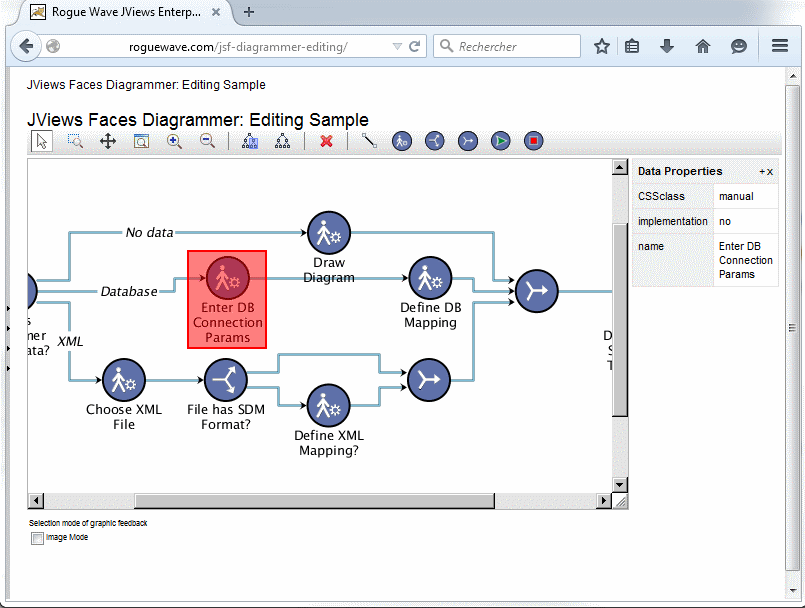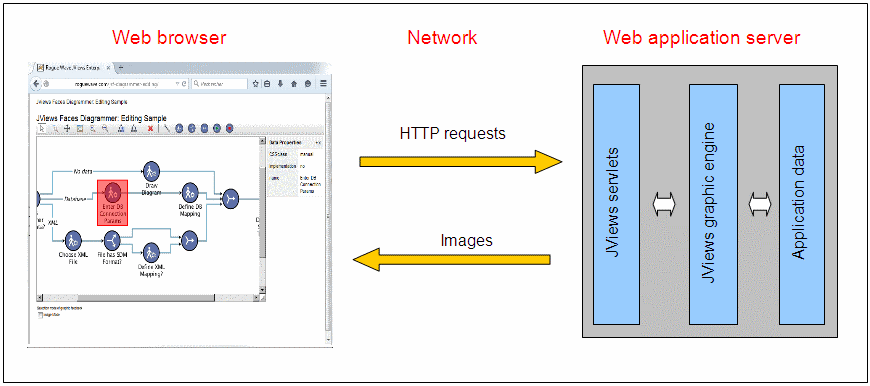For detailed information about exchange protocols between the
client and the server see JViews Web application client/server exchange
protocols.
JViews Web application client
On the client side, standard Web browsers such as Internet Explorer® and Firefox ® are the only software
required to use Rogue Wave® JViews Web applications. In other
words, JViews Web applications do not need any special plug-in
installed with the browser. This makes the deployment of JViews
Web applications very easy.
To understand the workings of JViews Web
applications, there are two important concepts to understand :
the view and the interactor.
The following figure shows a typical
JViews Web application.

A typical JViews Web application
The view
A view is an area in the browser that
shows graphical presentations. In the following example, the
view shows a portion of a JViews diagram. There are different
implementations of the view concept and they are designed to
show special graphic views such charts, diagrams, maps, Gantt
charts, etc.
At the HTML level, a view is implemented by
<div>
,
<img>
, and
<script>
elements. The
<img>
element is used to display the graphic view provided by JViews
servlets running on Web application servers.JViews servlets
generate images in
JPEG
,
PNG
, or
GIF
so they can be displayed by standard Web browsers.
A view is also a set of JavaScript classes that handle the
network communication with JViews servlets. For example, when
the graphic view is zoomed, the view needs to send the right
parameters to JViews servlets and to display the returned
image. For implementation details, see IlvView JavaScript class.
The interactor
An interactor is a JavaScript class that
handles user interactions with the graphic view. It makes the
view interactive. A very common interactor is the zoom
interactor. This interactor captures mouse events and works
with the view to make the presentation zoomed in or zoomed out.
Another typical interactor is the
select interactor that allows you to select one or more
graphic objects in the views. For example, the select
interactor performs the following tasks:
- Captures the mouse events in the view, such as a mouse click
- Communicates through the network with the JViews servlets to detect which objects are selected
- Displays feedbacks in the view to indicate the selected graphics objects.
Note that some interactors draw graphic primitives on the
screen to show feedbacks. These feedbacks are drawn in
VML
or
SVG
depending on the browser used. JViews detects automatically the
right technology to draw the primitives and does not need extra
plug-ins.
JViews servlet implementation
JViews server-side support is based on the Java™ servlet technology. Servlets are
Java programs that run on a Web application server. They act as a
middle layer between HTTP requests coming from a Web browser and
the application or databases on the Web server. The job of the
servlet is to read and interpret HTTP requests coming from an
HTTP client program and to generate a resulting document which in
most cases is an HTML page. For more information about servlet
technology, see the JavaSoft™
site http://java.sun.com/products/servlet.
On the server side, when HTTP requests are received, JViews
servlets rely on JViews graphic engines, such as JViews
Diagrammer, Charts, or Gantt charts, to render the graphic views
and then encode the presentations in
JPEG
,
PNG
, or
GIF
images, as illustrated in the following figure.

Ready-to-use servlets have been provided by JViews. For each
JViews graphic component, such as JViews Charts, Diagrammer, or
Gantt charts, special servlets have been implemented for both
rendering images and handling interactions. See IlvManagerServlet for an example of a
concrete JViews servlet implementation.